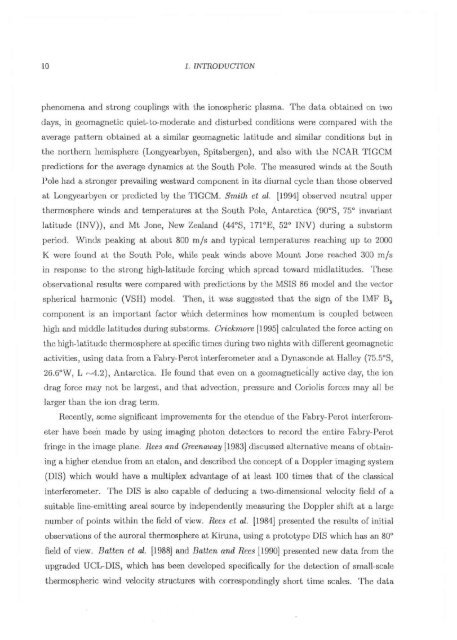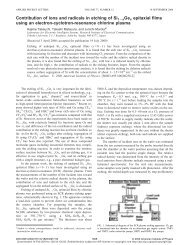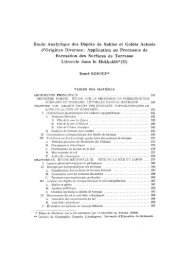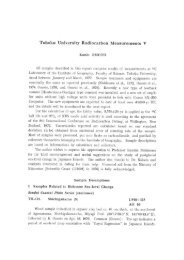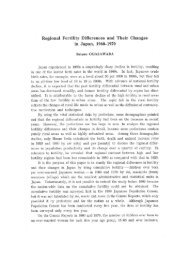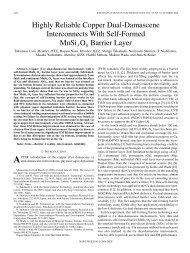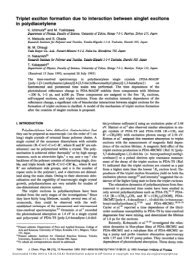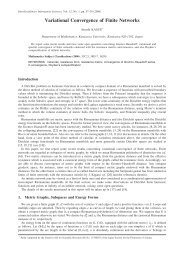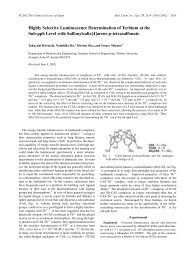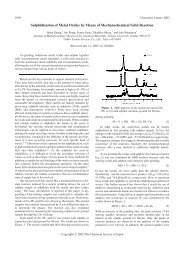MgE71241:1attf:3(t At-- 0 -3 5t5M I:. N1144±TitoD riziMinliJ VAT .9f 1 ...
MgE71241:1attf:3(t At-- 0 -3 5t5M I:. N1144±TitoD riziMinliJ VAT .9f 1 ...
MgE71241:1attf:3(t At-- 0 -3 5t5M I:. N1144±TitoD riziMinliJ VAT .9f 1 ...
You also want an ePaper? Increase the reach of your titles
YUMPU automatically turns print PDFs into web optimized ePapers that Google loves.
10 1. INTRODUCTION<br />
phenomena and strong couplings with the ionospheric plasma. The data obtained on two<br />
days, in geomagnetic quiet-to-moderate and disturbed conditions were compared with the<br />
average pattern obtained at a similar geomagnetic latitude and similar conditions but in<br />
the northern hemisphere (Longyearbyen, Spitsbergen), and also with the NCAR TIGCM<br />
predictions for the average dynamics at the South Pole. The measured winds at the South<br />
Pole had a stronger prevailing westward component in its diurnal cycle than those observed<br />
at Longyearbyen or predicted by the TIGCM. Smith et al. [1994] observed neutral upper<br />
thermosphere winds and temperatures at the South Pole, Antarctica (90°S, 75° invariant<br />
latitude (INV)), and Mt Jone, New Zealand (44°S, 171°E, 52° INV) during a substorm<br />
period. Winds peaking at about 800 m/s and typical temperatures reaching up to 2000<br />
K were found at the South Pole, while peak winds above Mount Jone reached 300 m/s<br />
in response to the strong high-latitude forcing which spread toward midlatitudes. These<br />
observational results were compared with predictions by the MSIS 86 model and the vector<br />
spherical harmonic (VSII) model. Then, it was suggested that the sign of the IMF By<br />
component is an important factor which determines how momentum is coupled between<br />
high and middle latitudes during substorms. Crickmore [1995] calculated the force acting on<br />
the high-latitude thermosphere at specific times during two nights with different geomagnetic<br />
activities, using data from a Fabry-Perot interferometer and a Dynasonde at Halley (75.5°S,<br />
26.6°W, L —4.2), Antarctica. He found that even on a geomagneticai Ily active day, the ion<br />
drag force may not be largest, and that advection, pressure and Coriolis forces may all be<br />
larger than the ion drag term.<br />
Recently, some significant improvements for the etendue of the Fabry-Perot interferom-<br />
eter have been made by using imaging photon detectors to record the entire Fabry-Perot<br />
fringe in the image plane. Rees and Greenaway [1983] discussed alternative means of obtain-<br />
ing a higher etendue from an etalon, and described the concept of a Doppler imaging system<br />
(DIS) which would have a multiplex advantage of at least 100 times that of the classical<br />
interferometer. The DIS is also capable of deducing a two-dimensional velocity field of a<br />
suitable line-emitting areal source by independently measuring the Doppler shift at a large<br />
number of points within the field of view. Rees et at. [1984] presented the results of initial<br />
observations of the auroral thermosphere at Kiruna, using a prototype DIS which has an 80°<br />
field of view. Batten et al. [1988] and Batten and Rees [1990] presented new data from the<br />
upgraded UCL-DIS, which has been developed specifically for the detection of small-scale<br />
thermospheric wind velocity structures with correspondingly short time scales. The data


